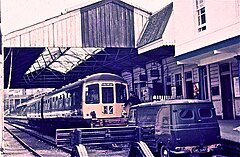This article includes a list of references, related reading, or external links, but its sources remain unclear because it lacks inline citations. (October 2009) |
| British Rail Class 103 | |
|---|---|
 A Class 103 at Kingswear station in 1972. | |
| In service | 1957–1983 |
| Manufacturer | Park Royal Vehicles |
| Family name | First generation |
| Replaced | Steam locomotives and carriages |
| Number built | 20 sets (40 cars) |
| Formation | 2 car sets: DMBS-DTCL |
| Capacity | DMBS: 52 second class; DTCL: 16 first and 48 second class |
| Operators | British Rail |
| Specifications | |
| Car length | 57 ft 6 in (17.53 m) |
| Width | 9 ft 3 in (2.82 m) |
| Maximum speed | 70 mph (110 km/h) |
| Weight | DMBS: 33 long tons 8 cwt (74,800 lb or 33.9 t) DTCL: 26 long tons 7 cwt (59,000 lb or 26.8 t) |
| Prime mover(s) | Two BUT (AEC) 6-cylinder diesels |
| Power output | 150 bhp (112 kW) each engine |
| Transmission | Mechanical: 4 speed epicyclic gearbox |
| Braking system(s) | Vacuum |
| Coupling system | Screw-link couplings, British Standard gangways |
| Multiple working | ■ Blue Square |
| Track gauge | 4 ft 8+1⁄2 in (1,435 mm) |
The British Rail Class 103 diesel multiple units were built by Park Royal Vehicles with diesel engines by British United Traction (BUT). Ordered in the first half of 1955, 20 of these sets were built by Park Royal at the Crossley Motors works in Stockport of the ACV Group. They consisted of a power car and a driving trailer. Standard BUT equipment was fitted, with 'A' type engines.
A two-car set with 16 first class and 100 second class seats weighed just under 60 long tons, representing 1,150 lb (520 kg) a seat and had 5 hp per ton of empty weight or 4.35 hp per ton when full.